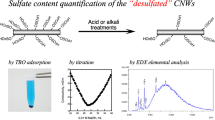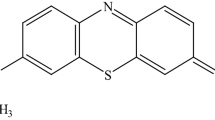Abstract
The surface carboxyl and sulfate groups on cellulose nanowhiskers were quantified via the adsorption of toluidine blue O (TBO), a cationic dye. Here, simple and rapid protocols, such as mixing the nanowhisker suspensions with a dye solution, separating the supernatants via centrifugation, and determining the excess dye concentration via visible light absorbance techniques, were used to obtain reproducible results comparable with those obtained via titration. In addition to facilitating the discrete quantification of the sulfate and carboxyl groups, the TBO adsorption method enabled carboxyl quantification in the presence of mercapto groups, which was difficult to achieve via titration. The adsorption of TBO onto the carboxyl groups was completed within 30 min, enabling the rapid treatment of many samples within a short period.
Graphic abstract





Similar content being viewed by others
Change history
01 August 2022
A Correction to this paper has been published: https://doi.org/10.1007/s10570-022-04758-5
References
Araki J (2013) Electrostatic or steric?–Preparations and characterizations of well-dispersed systems containing rod-like nanowhiskers of crystalline polysaccharides. Soft Matter 9:4125–4141
Araki J, Kuga S (2001) Effect of trace electrolyte on liquid crystal type of cellulose microcrystals. Langmuir 17:4493–4496
Araki J, Kuga S, Magoshi J (2002) Influence of reagent addition on carbodiimide-mediated amidation for poly(ethylene glycol) grafting. J Appl Polym Sci 85:1349–1352
Araki J, Wada M, Kuga S (2001) Steric stabilization of a cellulose microcrystal suspension by poly(ethylene glycol) grafting. Langmuir 17:21–27
Araki J, Wada M, Kuga S, Okano T (1998) Flow properties of microcrystalline cellulose suspension prepared by acid treatment of native cellulose. Coll Surf A 142:75–82
Araki J, Wada M, Kuga S, Okano T (1999) Influence of surface charge on viscosity behavior of cellulose microcrystal suspension. J Wood Sci 45:261–258
Araki J, Wada M, Kuga S, Okano T (2000a) Influence of surface charge on viscosity anomaly of microcrystalline cellulose suspensions. In: Nishinari K (ed) Hydrocolloids: physical chemistry and industrial application of gels, polysaccharides, and proteins. Elsevier, Amsterdam, pp 283–288
Araki J, Wada M, Kuga S, Okano T (2000b) Birefringent glassy phase of a cellulose microcrystal suspension. Langmuir 16:2413–2415
Batmaz R, Mohammed N, Zaman M, Minhas G, Berry RM, Tam KC (2014) Cellulose nanocrystals as promising adsorbents for the removal of cationic dyes. Cellulose 21:1655–1665
Bohrn R, Potthast A, Schiehser S, Rosenau T, Sixta H, Kosma P (2006) The FDAM method: determination of carboxyl profiles in cellulosic materials by combining group-selective fluorescence labeling with GPC. Biomacromol 7:1743–1750
Bondeson D, Mathew A, Oksman K (2006) Optimization of the isolation of nanocrystals from microcrystalline cellulose by acid hydrolysis. Cellulose 13:171–180
Chai XS, Hou QX, Zhu JY, Chen S, Wang SF, Lucia L (2003) Carboxyl groups in wood fibers. 1. Determination of carboxyl groups by headspace gas chromatography. Ind Eng Chem Res 42:5440–5444
Davidson GF (1948) 6 – The acidic properties of cotton cellulose and derived oxycelluloses. Part II. The absorption of methylene blue. J Textile Institute Trans 39:T65–T86
de Souza Lima MM, Borsali R (2004) Rodlike cellulose microcrystals: Structure, properties and applications. Macromol Rapid Commun 25:771–787
Eichhorn SJ (2011) Cellulose nanowhiskers: promising materials for advanced applications. Soft Matter 7:303–315
Fardim P, Moreno T, Holmbom B (2005) Anionic groups on cellulosic fiber surfaces investigated by XPS, FTIR-ATR, and different sorption methods. J Colloid Interface Sci 290:383–391
Fukuzumi H, Saito T, Okita Y, Isogai A (2010) Thermal stabilization of TEMPO-oxidized cellulose. Polym Degrad Stab 95:1502–1508
Habibi Y, Lucia LA, Rojas OJ (2010) Cellulose nanocrystals: chemistry, self-assembly, and applications. Chem Rev 110:3479–3500
ISO 21400 (2018). Pulp – Determination of cellulose nanocrystal sulfur and sulfate half-ester content. https://www.iso.org/standard/70861.html
Isogai A, Saito T, Fukuzumi H (2011) TEMPO-oxidized cellulose nanofibers. Nanoscale 3:71–85
Johnston LJ, Jakubek ZJ, Beck S, Araki J, Cranston ED, Danumah C, Fox D, Li H, Wang J, Mester Z, Moores A, Murphy K, Rabb SA, Rudie A, Stephan C (2018) Determination of sulfur and sulfate half-ester content in cellulose nanocrystals: an interlaboratory comparison. Metrologia 55:872
Kumar V, Yang T (1999) Analysis of carboxyl content in oxidized celluloses by solid-state 13C CP/MAS NMR spectroscopy. Int J Pharm 184:219–226
Rödiger S, Ruhland M, Schmidt C, Schröder C, Grossmann K, Böhm A, Nitschke J, Berger I, Schimke I, Schierack P (2011) Fluorescence dye adsorption assay to quantify carboxyl groups on the surface of poly(methyl methacrylate) microbeads. Anal Chem 83:3379–3385
Sano S, Kato K, Ikada Y (1993) Introduction of functional groups onto the surface of polyethylene for protein immobilization. Biomaterials 14:817–822
Soedjak HS (1994) Colorimetric determination of carrageenans and other anionic hydrocolloids with methylene blue. Anal Chem 66:4514–4518
Tiraferri A, Elimelech M (2012) Direct quantification of negatively charged functional groups on membrane surfaces. J Membrane Sci 389:499–508
Urata T, Araki J (2020) Adsorption of silver nanoparticles onto cellulose nanowhiskers incorporating thiol groups. Manuscript in preparation (presented at Tsukuba Global Science Week 2020 (TGSW2020), September 2020, Tsukuba, Japan)
Wilson WK, Mandel J (1961) Determination of carboxyl in cellulose. Comparison of various methods TAPPI-ACS-ASTM-ICCA subcommittee on determination of carboxyl. Tappi 44:131–137
Wu N, Wan X, Liu B, Chai XS (2018) Headspace A simple and efficient headspace gas chromatographic method for the determination of carboxyl groups in nanofibrillated cellulose. Cellulose 25:953–959
Yan N, Chai XS, Runge T (2021) A simple multi-wavelength spectroscopic method for the determination of carboxyl group content in nanocellulose. Cellulose 28:2805–2811
Zhu S, Panne U, Rurack K (2013) A rapid method for the assessment of the surface group density of carboxylic acid-functionalized polystyrene microparticles. Analyst 138:2924–2930
Acknowledgments
The author is grateful to Hyogo Okuda, Minami Nakajima, Takafumi Shimizu, Torino Kosaka, Teppei Ueda, Naoya Ohsawa, Yoichi Sasaki, Itsuki Takebe, Yasumasa Honmura, Erika Kotaki, and Takahiro Suzuki (Shinshu University) for conducting the titration experiments of the various nanowhisker samples. Yusuke Okada and Sachiko Yoshioka (Shinshu University) are acknowledged for their kind assistance in X-ray diffraction and FT-IR measurements, respectively. The author acknowledges DKS Co. Ltd. for kind donation of the TEMPO-oxidized cellulose nanofiber sample.
Author information
Authors and Affiliations
Corresponding author
Ethics declarations
Conflict of interest
The authors have no conflicts of interest to declare that they are relevant to the content of this article.
Human and animal rights
This article does not contain any studies with human participants or animals performed by any of the authors.
Additional information
Publisher's Note
Springer Nature remains neutral with regard to jurisdictional claims in published maps and institutional affiliations.
Supplementary Information
Below is the link to the electronic supplementary material.
Rights and permissions
Springer Nature or its licensor holds exclusive rights to this article under a publishing agreement with the author(s) or other rightsholder(s); author self-archiving of the accepted manuscript version of this article is solely governed by the terms of such publishing agreement and applicable law.
About this article
Cite this article
Araki, J. Dye adsorption revisited: application of the cationic dye adsorption method for the quantitative determination of the acidic surface groups of nanocellulose materials. Cellulose 28, 7707–7715 (2021). https://doi.org/10.1007/s10570-021-04035-x
Received:
Accepted:
Published:
Issue Date:
DOI: https://doi.org/10.1007/s10570-021-04035-x




